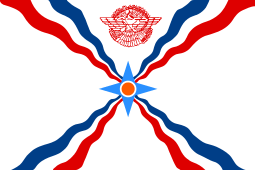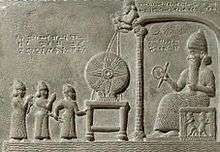Assyrian flag
 | |
| Use | National flag |
|---|---|
| Adopted | 1971 |
| Design |
White background with a golden circle at the center, surrounded by a four-pointed star in blue. Four triple-coloured (red-white-blue), widening, wavy stripes connect the center to the four corners of the flag. |
| Designed by | George Bit Atanus |
The Assyrian flag is the flag chosen by the Assyrian people to represent the Assyrian nation in the homeland and in the diaspora.
George Bit Atanus first designed the flag in 1968. The Assyrian Universal Alliance, Assyrian National Federation and Bet-Nahrain Democratic Party all adopted it in 1971. The flag has a white background with a golden circle at the center, surrounded by a four-pointed star in blue. Four triple-colored (red-white-blue), widening, wavy stripes connect the center to the four corners of the flag. The figure of pre-Christian Assyrian god Assur, known from Iron Age iconography, features above the center.
Symbolism
The golden circle at the center that represents the sun, which, by its exploding and leaping flames, generates heat and light to sustain the earth and all its living things. The four pointed star surrounding the sun symbolizes the land, its light blue color symbolizing tranquility.
The wavy stripes extending from the center to the four corners of the flag represent the three major rivers of the Assyrian homeland: the Tigris, the Euphrates, and the Great Zab. The lines are small at the center and become wider as they spread out from the circle. The dark blue represents the Euphrates. The red stripes, whose blood red hue stands for courage, glory and pride, represent the Tigris. The white lines in between the two great rivers symbolizes the Great Zab; its white color stands for tranquility and peace. Some interpret the red, white and blue stripes as the highways that will take the scattered Assyrians back to their ancestral homeland.[1] It is also said that when the stripes are reversed with the red stripes on top and the blue stripes on bottom, it symbolizes that the nation is at war.
The archer figure symbolizes the pre-Christian god Assur.[2]
Previous flags

.svg.png)
Prior to World War I, the Assyrian flag consisted of 3 layers of salmon, white, and red. On the top left of the first layer, 3 white stars represented the three main Churches of the Assyrian people: Church of the East, Chaldean Catholic Church, and Syriac Orthodox Church (it is also used by members of the Syriac Catholic Church). This flag was used during delegation meetings with Assyrian politicians and Western powers during and post World War I. The flag was used until the current design was established. The flag was created by the Syriac Orthodox community of Tur Abdin.
Between 1915 and 1923, the Assyrian army used a flag that resembled the flag of Switzerland. It consisted of a red background, indicating the blood spilled by the Assyrians prior to and during World War I, and a white cross. The top left corner contained a round seal, which was Agha Petros's personal stamp. The seal had his name on it in two languages (Assyrian and Russian).
Gallery
-

The "feather-robed archer" figure in the 1968 flag is inspired by Assyrian Empire period iconography.
-

Star symbol in the Mor Gabriel monastery.
-
.svg.png)
The flag of Iraq 1959-1963 included a red star symbolic of the Assyrian minority.
- ^ http://www.britannica.com/EBchecked/topic/538274/Shamash
- ^ "Syriac-Aramaic People (Syria)". Crwflags.com. Archived from the original on 4 December 2008. Retrieved 2008-11-16.
- ^ http://chaldeanflag.com/flag.html
References
- ↑ Ashurian, Homer (2000-06-02). "The Origins and Description of the Assyrian Flag". Atour.com. Retrieved 2012-08-17.
- ↑ "The Origins and Description of the Assyrian Flag" by Homer Ashurian, Assyrian Universal Alliance, 03-1999 Archived February 17, 2009, at the Wayback Machine.
External links
- Assyrian Information Management (AIM) - The Origins and Description of the Assyrian Flag
- Assyrian International News Agency (AINA)
- Assyrian flag at Flags of the World
- The Origins and Description of the Assyrian Flag


